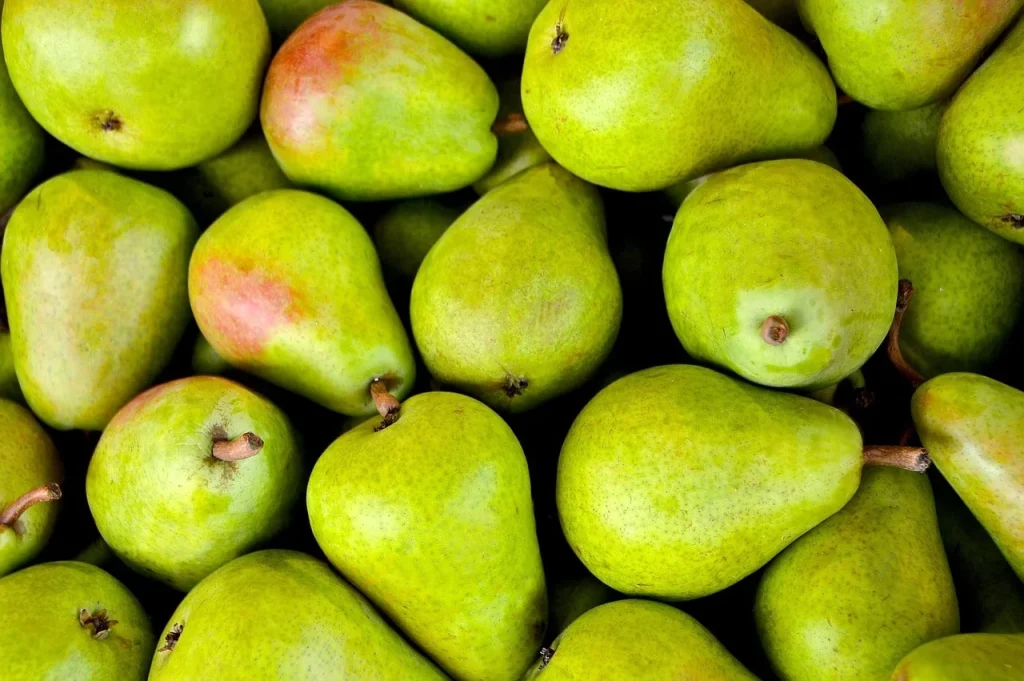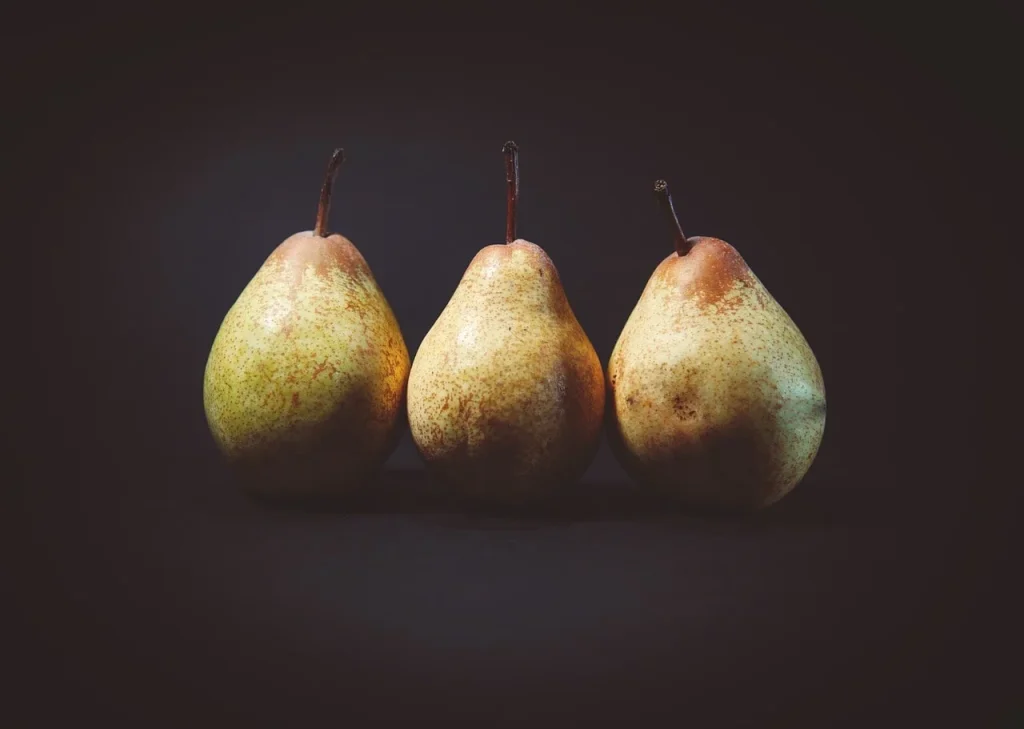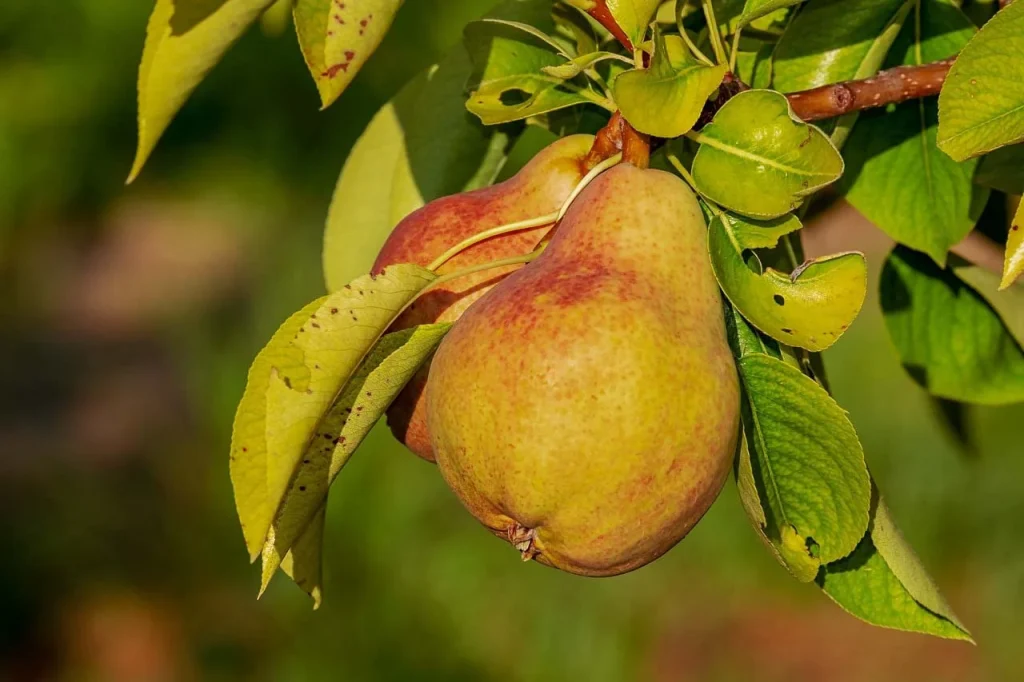Pears, a beloved fruit across many cultures, are as versatile as they are nutritious. But how much do you really know about them?
This article brings you some fun facts about pears that go beyond their sweet flavor. We’ll look at how they can improve your health, their different varieties, and some quirky historical facts that are sure to pique your interest. By the end of this read, you’ll see pears in a whole new light!
Pears, the lyres of fruit. How sweet their music to the mouth!
Cassandra Danz
Pear Facts
Welcome to our juicy journey through the realm of pears! Every section is packed with facts and information, so read carefully if you’re aiming to ace the quiz at the article’s end and prove your pear prowess.
- This fruit can actually ripen from the inside out, which is why they can sometimes feel hard on the outside yet be overripe inside.
- The oldest known mention dates back to 5,000 B.C. in Cuneiform tablets.
- China leads the world in production, cultivating about 68% of the global supply.
- Their trees are one of the longest-living fruit trees; some are still productive after 75 years.
- There are over 3,000 varieties worldwide.
- Napoleon Bonaparte is responsible for popularizing the cultivation of this fruit in France.
- They can be fermented to produce perry, an alcoholic beverage similar to cider but made from this specific fruit.
- High in dietary fiber, one medium piece contains about 24% of the recommended daily intake.
- According to folklore, a fruit wood spoon will sweeten anything it stirs.
- The phrase “to give a pear-shaped” meaning has origins in the British Royal Air Force, describing things going wrong.
- Not only the fruit but also the leaves and twigs are edible and contain health-benefiting qualities.
- The wood is prized for making musical instruments and fine furniture due to its durability and aesthetic appeal.
- Botanically, they belong to the same family as apples and roses.

- Archaeologists found evidence suggesting that humans consumed them during the Iron Age.
- They naturally contain hydroxycinnamic acid, which helps prevent stomach cancer.
- The high level of fructose and glucose in these fruits provides a natural energy boost.
- One variety known as the “Bradford” is particularly notorious for its weak wood, making it prone to breaking during storms.
- Some cultures view them as symbols of immortality and feminine beauty.
- In Renaissance artwork, they often symbolize the Virgin Mary’s purity and sweetness.
- Their flowers are usually white and appear early in the spring, before the leaves.
- A favorite medium for botanical artists, their complex shape and texture present a delightful challenge to depict.
- They are climacteric fruits, meaning they ripen off the tree after being picked.
- Stored in a cool, dark place, they can last for several weeks.
- Unlike most fruits, they improve in texture and flavor after they’re picked.
- Asian varieties are typically rounder, crisper, and have a different texture compared to European types.
- Kieffer, a type grown mostly in the Southern U.S., is often used for canning and preserves.
- Their skins, rich in nutrients, are an excellent source of vitamin C, vitamin K, and copper.
- Eating one before meals can help control blood sugar levels effectively.

- Their seeds, like those of apples, contain trace amounts of cyanide, though not enough to be harmful unless consumed in large quantities.
- During the Chinese New Year, it’s considered bad luck to share a pear, as it may symbolize separation.
- Historically, they were used medicinally to treat everything from colitis to chronic gallbladder disorders.
- The first recorded gift of this fruit tree was by Roman Emperor Caligula to the King of Mauritania.
- Their juice can also be used as a natural meat tenderizer.
- Unlike many fruits, they do not change color as they ripen.
- They were once called “butter fruit” for their soft, butter-like texture.
- When cut, they oxidize very quickly, turning the flesh brown; a sprinkle of lemon juice can prevent this.
- In the U.S., Oregon and Washington are the largest producers, thanks to their ideal temperate climates.
- Some specialty varieties are grown only in certain regions, like the Comice in the Rogue Valley of Oregon.

- Their bloom period is a popular tourist attraction in regions known for cultivation.
- They are one of the few fruits that never create an allergic reaction in humans.
- Often given as gifts in Korea, they symbolize grace and comfort.
- They are an excellent source of potassium, which helps in lowering blood pressure.
- Their delicate skin can bruise easily, which doesn’t affect the taste but makes them less visually appealing.
- Grilling or poaching can enhance their natural sweetness and make a savory dish sweet.
- Bartlett in North America is known as Williams in other parts of the world, and it’s one of the most popular varieties.
- Traditionally, farmers believed that planting garlic near the trees would improve their health and fruit quality.
- In traditional medicine, their extracts are used for detoxifying, enhancing immune function, and lowering cholesterol.
- They are very sensitive to their growing environment, making their cultivation a true art form in some regions.
- The ancient Greeks valued this fruit for its anti-inflammatory properties.
- In modern fine dining, chefs often use them in both savory and dessert dishes for their versatile flavor and texture.
Pear Myths

Now that we’ve explored the facts, let’s move on to debunking some common myths. We’ll separate truth from fiction to ensure you have a clear picture.
- Pears need to be peeled before eating
The peel of a pear is known to be rich in nutrients and fiber. Often, it is recommended that pears be eaten with their skin intact to fully benefit from their nutritional properties. - Pears are high in calories
They are actually low in calories. A medium-sized pear typically contains about 100 calories, making it an excellent choice for anyone monitoring their calorie intake. - Pears are not as nutritious as apples
They are packed with essential nutrients, just like apples. They are particularly rich in fiber, vitamin C, and potassium, contributing beneficially to a balanced diet. - Pears should be soft before they are ripe enough to eat
The ripeness of pears is not necessarily indicated by their softness. Many varieties are best enjoyed when they are still firm and only slightly under pressure near the stem. - Pears can only be eaten raw
The versatility of pears is often underestimated. They can be cooked, baked, and poached, making them a delightful addition to various recipes, both sweet and savory.
No products found.
Pear Quotes

We continue with some of my favorite quotes about pears. Feel free to share yours in the comments so I can add them to the list as well.
On a pear tree planted in his garden, Newton watched an apple fall.
Evan Esar
Evan Esar, a 20th-century American humorist, wittily remarks on Newton’s gravitational discovery with a playful twist involving a pear tree instead of the traditional apple tree narrative.
There are only ten minutes in the life of a pear when it is perfect to eat.
Ralph Waldo Emerson
Emerson, the renowned American essayist, reflects on the fleeting moment when a pear is in its perfect state for consumption, highlighting the ephemeral nature of perfection.
When you have a great and difficult task, something perhaps almost impossible, if you only work a little at a time, every day a little, suddenly the work will finish itself.
Isak Dinesen
Isak Dinesen (Karen Blixen), a celebrated Danish author, used the analogy of eating a pear bit by bit to describe how large tasks can be accomplished gradually over time.
The pear tree in the yard is so old, it looks like all the other trees come there when they are sick.
Robert Benchley
Robert Benchley, an American humorist and writer, humorously comments on the decrepit state of an old pear tree, imagining it as a gathering place for other ailing trees.
Life without love is like a tree without blossoms or fruit.
Khalil Gibran
Khalil Gibran, a philosophical essayist, in his broader reflections on love and life, could easily be imagined noting that a life without love is barren, much like a fruit tree (such as a pear tree) that does not bloom or bear fruit.
Pear FAQ

Having enjoyed those sweet quotes, it’s time to dive into the FAQs. This is the last read before your quiz, so make sure to absorb every bit of information!
- Are pear trees self-pollinating?
Not all pear trees are self-pollinating. Most pear varieties need cross-pollination from a different pear tree variety to produce fruit. However, some varieties, like ‘Bartlett’, can self-pollinate to some extent but will produce more fruit with a pollination partner. - Can pears be frozen?
Yes, they can be frozen, but it’s best to peel, core, and slice them first. To prevent browning, you might want to coat the slices with a solution of lemon juice and water. Frozen pears are great for smoothies or baking. - Are pear seeds poisonous?
Pear seeds contain a small amount of amygdalin, a compound that the body converts into cyanide. While eating a few seeds accidentally is not harmful, consuming a large quantity can be dangerous. It’s best to avoid eating pear seeds. - Can pears help with constipation?
Absolutely! They are rich in fiber, which can help regulate bowel movements. Eating pears, especially with their skin, can be a delicious way to alleviate constipation. - Are pears good for dogs?
They are safe and healthy for dogs in moderation. They provide a good source of vitamin C, vitamin A, and fiber. However, make sure to remove the core and seeds first, and give pears as an occasional treat rather than a regular part of their diet.
No products found.
Pear Trivia

Welcome to our pear-fectly challenging quiz! Brace yourself—get zero right, and you might just turn into a pear yourself. Proceed at your own risk!
Pear Merch
If you are a true fan of pears, then you definitely need to check out our merchandise. You can find T-shirts, hoodies, mugs, and tote bags for your favorite designs. Feel free to check out all the other designs in our shop.
Conclusion
In conclusion, pears are truly fascinating. They’re not only a healthy snack but also a part of our global heritage. With varieties from around the world, there’s a pear out there for everyone.
They can be enjoyed in numerous ways, with each method bringing out a different flavor and texture. So, keep exploring the possibilities and find your perfect pear match! Till next time, stay curious and explore more. Cheers.


